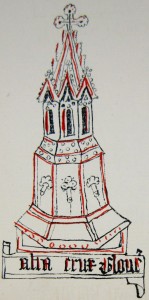Every year, on New Year’s Eve, young and not-so-young Gloucester residents gather at ‘The Cross’ to celebrate the coming of the New Year. The vast majority of them believe that The Cross is so-named because it is where the four ‘Gate’ streets meet in the middle of the city. Not so! It is named after the original stone memorial cross that stood at the junction for hundreds of years.
Known as the High Cross or Alta Crux, it began its life as far back as the 13th century. In a rental compiled in 1455 (Gloucestershire Archives reference: GBR J5/1) there is a sketch of the cross as it was in the 15th century, showing how the lower section had been adapted with pipes to supply water to the city centre, brought from Robinswood Hill.
It is believed that the Cross was rebuilt during the reign of Henry VII and again during the reign of his son, Henry VIII.
By the eighteen century, the memorial stood nearly 35 feet tall; the edifice was octagonal in shape at the base and, above that it consisted of two sections plus a steeple. The lower section held the water pipes whilst the upper of the two sections held statues of previous sovereigns of England. They were of King John, Henry III and Eleanor his wife, Edward III, Richard II, Richard III, Elizabeth I and Charles I.
A more impressive, more recent image of the High Cross graces the wall at Gloucestershire Archives. It shows an engraving made by George Vertue after a sketch by T. Ricketts.
This magnificent piece of sculpture stood proudly in the centre of Gloucester until 1751, when it was considered to be a nuisance to passing traffic. A small item in the Gloucester Journal dated 5th November 1751 states:
This week was taken down, for better Conveniency of Carriages, our ANTIENT CROSS, round which were the Effigies of several of our illustrious Kings and Queens; of which curious Pieces of Antiquity particular Draughts have, however, been taken by the Famous Mr Rickets of this City, pursuant to an Order from the Society of Antiquities in London, to whom they are sent that they may be preserv’d to latest Posterity.
A rarely-accessed treasure recently surfaced during my research at Gloucestershire Archives. It took the form of a small book, handwritten in the 1750s by Samuel Gwinnett, junior. His father, the Reverend Samuel Gwinnett, was the vicar of Down Hatherley near Gloucester but also the curate of St. Nicholas Church in Westgate Street. Hence, young Samuel was very familiar with the centre of the city.
Whilst at University in Oxford, Samuel, junior, had written a series of poems, many to a young woman he called ‘Celia of Gloucester’, obviously the love of his life at that time. Tucked amongst these poems was one relating to the destruction of Gloucester’s High Cross, as follows.
On Our Worthy Corporation of
Gloucester’s pulling down the Cross
venerable with the statues of our old kings
upon his majesty’s Birthday.
When factions banish’d Quiet from the Plain
And wild Disorder shook a Stewart’s Reign
Gotham’s rude Sons, for Civil Discord fam’d
At Monarch Sway with deadly rancour teem’d
Nor ceas’d to thunder with Rebellion’s Tongues,
‘Till Charles’s Blood assuag’d their groundless Wrongs.
Republic Maxim’s did their bosoms fire,
And still the Youngkling apes his Patriot Sire.
For tho’ each Burgher round the Festive Bowl
To Thee, Great George! May pledge his drunken soul;
Yet should black Clouds arise, & strike at Kingly Power
To distant Climes thy tender Offspring drive,
Nor let one Mark of Royalty survive!
For while in gaudy Pomp & rich Array,
Brittania joyous hails thy Natal Day:
While Laureate Cibber’s in Bastion Rhimes
Applauds the Blessings of the present Times!-
With impious hands lo! Gotham’s Senate dare
Deform those Busts, that Regal Badges wear.
Blush! Blush! Nor thus your Zeal to Kings proclaim; –
For who at once reveres & stabs a name?
Samuel Gwinnett, junior, c.1751

